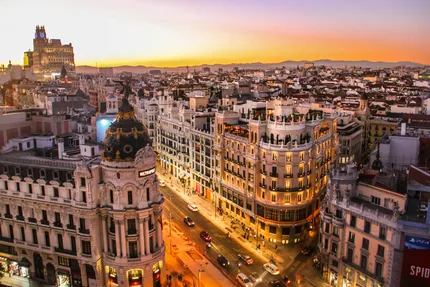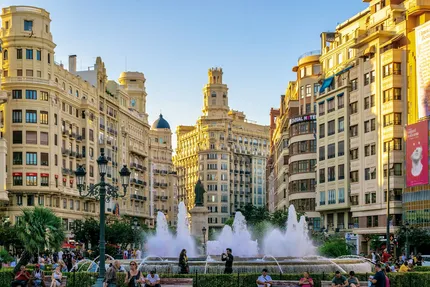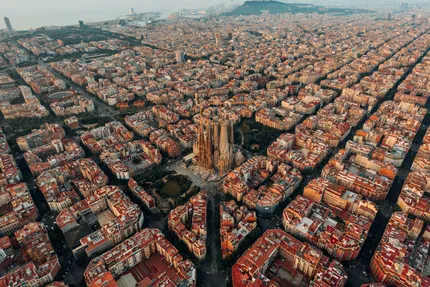CityTouring
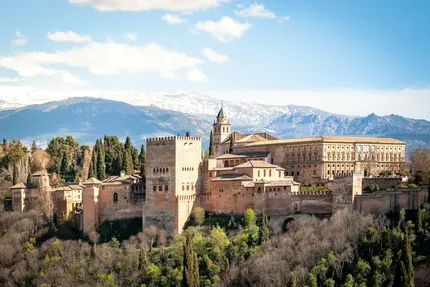
City trip to Granada
SpainGranada sits where the plains of Andalusia rise to the Sierra Nevada, a compact city shaped by centuries of Moorish and Christian rule. The Alhambra—its palaces, patios, and Generalife gardens—dominates the skyline, while the whitewashed Albaicín winds up the opposite hill with cobbled lanes and jasmine-scented courtyards to the Mirador de San Nicolás. Below, the Renaissance Cathedral and the Royal Chapel reflect Spain’s Catholic Monarchs, and the riverside Carrera del Darro leads to the lively Paseo de los Tristes beneath the fortress walls. In Sacromonte, traditional cave dwellings host late-night flamenco.
Everyday life centers on plazas and bars where a drink arrives with a free tapa, a tradition students and locals keep alive. Teterías and the Alcaicería market recall North African ties; the Realejo quarter adds street art and cafes; the Parque de las Ciencias brings hands-on exhibits. Granada is walkable, friendly to budgets, and easy to navigate, with viewpoints everywhere and mountains on the horizon. Its pace blends old and new, making short stays feel full without being rushed.

The Alhambra
Granada’s iconic hilltop fortress-palace complex showcases exquisite Nasrid architecture, from intricate stucco and tilework in the Palacios Nazaríes to the imposing Alcazaba towers. Book timed tickets well in advance; palace access is strictly scheduled. Wander gardens and ramparts for sweeping views of the city and Sierra Nevada, especially atmospheric at sunrise or late afternoon.
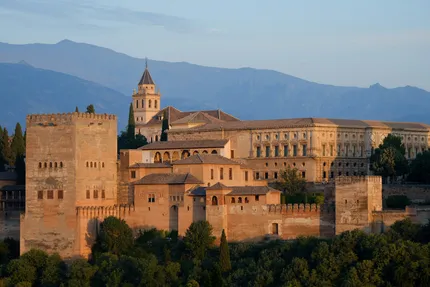
Albaicín & Mirador de San Nicolás
Explore the UNESCO-listed Moorish quarter’s narrow, steep lanes, whitewashed houses, and carmenes (walled homes with gardens). Climb to Mirador de San Nicolás for the classic Alhambra-and-Sierra panorama, especially stunning at sunset. Browse tea houses and craft shops along Calderería Nueva, and seek quieter viewpoints like San Cristóbal for different angles over rooftops and valleys.
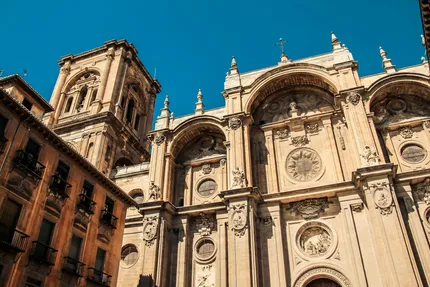
Granada Cathedral & Royal Chapel
At Granada’s heart, the Renaissance Cathedral impresses with towering columns, a bright nave, and a notable façade by Diego de Siloé. Adjacent, the Royal Chapel houses the tombs of Ferdinand and Isabella, plus a fine collection of Flemish paintings and reliquaries. Audio guides explain politics, art, and Spain’s pivotal transition from medieval to modern.
Granada suits travelers who want intense culture in a small radius. History and architecture enthusiasts will find days’ worth of detail: Nasrid plasterwork and cedar ceilings in the Alhambra, the Bañuelo’s 11th‑century Arab baths, the Renaissance Cathedral, and the Royal Chapel with the tombs of Isabel and Fernando. Photographers and sunset chasers get reliable rewards at Mirador de San Nicolás, San Cristóbal, and lesser‑known carmenes gardens. Food‑focused visitors who enjoy grazing will appreciate the free‑tapa tradition, affordable menus in Realejo and around Plaza de la Romanilla, and North‑African tea houses and pastries on Calderería. Flamenco fans can attend intimate zambra shows in Sacromonte’s cave venues. Couples often combine panoramic viewpoints with hammam sessions and evening strolls along the Paseo de los Tristes. Families have easy wins: the interactive Parque de las Ciencias, short riverfront walks on the Carrera del Darro, and the Carmen de los Mártires gardens.
Students and budget travelers benefit from low prices and lively bar life centered near the university. Active travelers can pair the city with nearby nature: Sierra Nevada hiking in late spring–autumn, winter skiing, or the hanging bridges of Monachil’s Los Cahorros gorge. Craft shoppers can seek taracea (wood marquetry) and Fajalauza ceramics. Note that the Albaicín and Sacromonte are steep and cobbled; plan footwear and use buses or taxis if hills are a concern. For a 2–3 day city break, Granada delivers depth without logistics overload.
Three top reasons for a city trip to Granada
- Explore the Alhambra's Nasrid Palaces, Court of the Lions, Alcazaba, and Generalife gardens; marvel at muqarnas, carved cedar, reflecting pools, and panoramic views over Granada and Sierra Nevada at sunset.
- Wander Albaicín's steep cobblestone alleys and whitewashed carmenes, climb to Mirador de San Nicolás for iconic Alhambra vistas, then experience zambra flamenco in Sacromonte's cave venues along Camino del Sacromonte.
- Embrace Granada's free-tapas culture: order drinks and receive generous plates on Calle Navas, Plaza Nueva, and Realejo; try tortilla del Sacromonte, piononos from Santa Fe, and Cervezas Alhambra or wines.
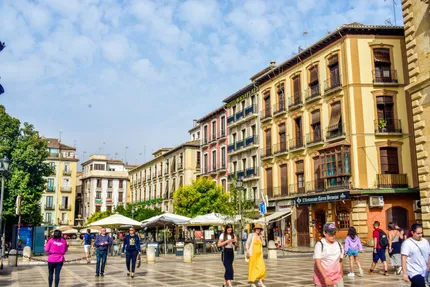
Best time to visit Granada
Spring (April–June) and early autumn (September–October) offer the best mix of mild temperatures, clear light, and manageable crowds. You can linger in the Alhambra and Generalife without peak heat, and evenings in the Albaicín are comfortable. Book Alhambra tickets several weeks ahead year-round; consider a late-afternoon or night visit in summer for cooler conditions. July and August can be very hot at midday, so plan siestas and early starts. Winter brings crisp, often sunny days, thinner queues, and Sierra Nevada’s ski season a short drive away, though nights are cold. Major events like Semana Santa and Corpus Christi add atmosphere but raise demand.
More activities and things to see in Granada:
Generalife Gardens
Stroll the Generalife, the Nasrid sultans’ summer retreat, with cooling water channels, aromatic plants, and elegant courtyards. The Patio de la Acequia and the Sultana’s Cypress Walk showcase refined landscaping and hydraulic ingenuity. Elevated terraces grant superb perspectives of the Alhambra and city. Entry is often included with Alhambra tickets; allow unhurried time.
Sacromonte Caves & Flamenco
On Granada’s eastern hillside, Sacromonte is known for whitewashed cave dwellings and intimate flamenco zambra performances. Visit the Sacromonte Caves Museum to learn how troglodyte homes functioned, and the abbey for relics and views. Evening shows combine song, guitar, and dance in atmospheric caves; booking ahead is advisable in peak seasons.
Carrera del Darro & Paseo de los Tristes
Walk along the Darro River beneath the Alhambra’s walls, crossing ancient stone bridges between Carrera del Darro and Paseo de los Tristes. Historic facades, small churches, and cafes line the route, with street performers at dusk. It’s one of Granada’s most photogenic strolls, ideal for golden-hour views and relaxed people-watching.
The Bañuelo (Arab Baths)
One of Spain’s best-preserved 11th-century Arab baths, the Bañuelo offers insight into Andalusi hygiene and social life. Star-shaped skylights puncture brick vaults over cold, warm, and hot rooms. Modest but atmospheric, it pairs well with nearby historic houses. Information panels help interpret features; combined tickets sometimes cover multiple monuments along the Darro.
Monasterio de la Cartuja
This Carthusian monastery hides an exuberant Baroque interior behind austere walls. The sacristy dazzles with swirling stucco, colored marble, and gilded altars, while works by Sánchez Cotán hang in the refectory. Quiet cloisters and chapels invite slow exploration. It’s a short bus ride from the center; guided visits enrich the symbolism.
Corral del Carbón
Dating to the 14th century, this former Nasrid caravanserai served merchants with lodging and storage, later becoming a coal yard. Its monumental horseshoe portal leads to a serene courtyard surrounded by galleries. Today it hosts cultural events and houses offices; entry is usually free, making it an easy, authentic architectural stop downtown.
Carmen de los Mártires Gardens
Adjacent to the Alhambra complex, these romantic gardens blend French, English, and Nasrid influences with ponds, fountains, terraces, and roaming peacocks. It’s a peaceful escape from crowds, offering vantage points over Granada and the Vega plain. Bring water and time a visit for late afternoon shade; entry is typically free or inexpensive.
Sierra Nevada Day Trip
Less than an hour from Granada, the Sierra Nevada offers winter skiing and long summer hikes among Spain’s highest peaks, including Veleta. Trails, chairlifts, and viewpoints deliver big-mountain scenery and cool air. Buses run to Pradollano; driving offers flexibility. Check weather and altitude impacts, and pack layers, sunscreen, and water.
Tapas Culture & Calle Navas
Experience Granada’s famed free-tapa-with-drink tradition. Hop between bars on Calle Navas, Plaza Nueva, and Calle Elvira, sampling local favorites like berenjenas con miel, habas con jamón, and regional cheeses. Weekends get crowded; stand at the bar for faster service. Order drinks in rounds to discover different tapas, and finish with a pionono.
Getting around in Granada
Granada’s compact core is best explored on foot. Expect steep, cobblestoned lanes in the Albaicín and the climb to the Alhambra; good shoes help. Driving in the historic quarters is restricted and parking is scarce and expensive, so a car isn’t practical for city sightseeing. The municipal bus network (Transportes Rober) is extensive and affordable; frequent C‑line minibuses connect the Alhambra, Albaicín, and Sacromonte, useful for the hills. The single‑line Granada Metro (light rail) runs north–south between Albolote and Armilla, linking the bus station, rail station, university areas, and shopping zones, with trains every few minutes. Tickets are inexpensive, and rechargeable travel cards reduce fares across buses and metro. Taxis are easy to hail and reasonably priced for short hops, especially at night or for hilltop districts. Cycling is improving on flatter corridors like Camino de Ronda and along the Genil, but gradients and cobbles limit bike convenience in the old city; e‑bikes help. For regional outings, frequent interurban buses run from the bus station.
Getting to Granada
Federico García Lorca Granada–Jaén Airport (GRX), 17 km west, has limited but useful service, mainly domestic links (e.g., Madrid, Barcelona) and occasional seasonal internationals. An airport coach meets most flights and reaches central stops like Gran Vía in about 30–45 minutes; taxis take ~25 minutes. For broad international options, Málaga–Costa del Sol Airport (AGP) is the main gateway, with plentiful flights across Europe and beyond. From AGP, ALSA runs direct coaches to Granada (about 2–2.5 hours); alternatively, take a train from Málaga María Zambrano via Antequera to Granada. By rail, Granada’s AVE/Alvia services connect with Madrid in roughly 3.5 hours and with Barcelona either direct or with a change (about 6–7 hours). Links to Córdoba, Seville, and Málaga generally involve a change at Antequera. Long‑distance buses (ALSA) are frequent and economical: Madrid (4.5–5.5 hours), Seville (~3 hours), Málaga (1.5–2 hours), Córdoba (~2.5 hours), Valencia (~6–7 hours). Trains arrive at Estación de Granada near Avenida de Andaluces; coaches use the Estación de Autobuses north of the center.
